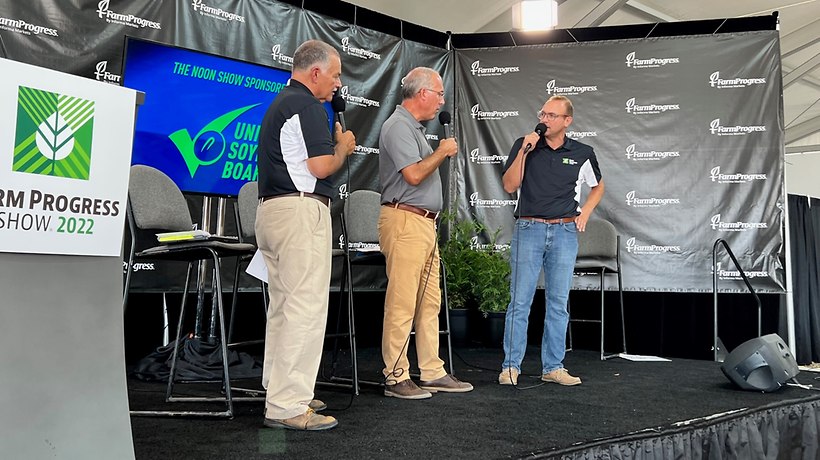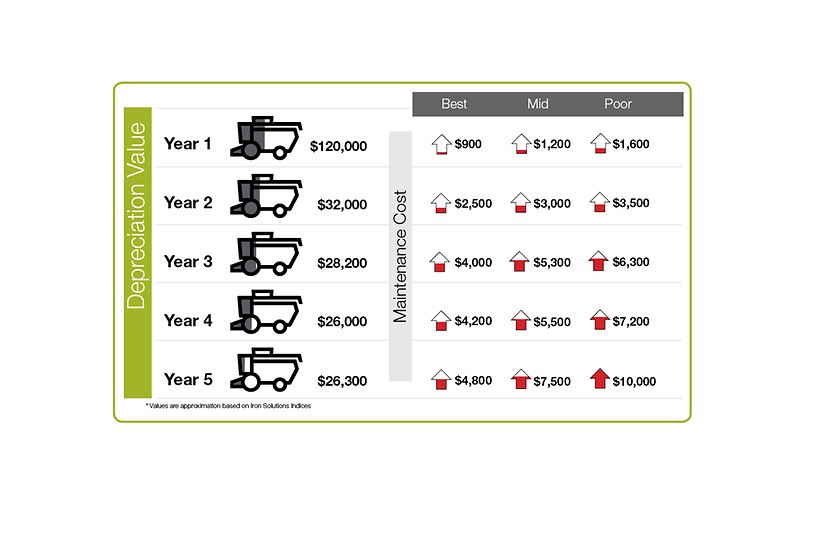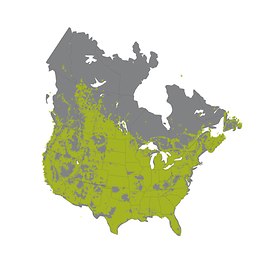

The Economics of Machine Values
The machine you use each season can make a huge difference in the profitability of your operation. At CLAAS, our goal is to arm you with the information you need to make informed business decisions that impact your bottom line.
According to research conducted by IronSolutions®, a third-party trusted partner providing industry appraisal and value forecasting of equipment, there are three key economic influencers that impact the buying decision:
- Capital expense of machine;
- Maintenance and repair costs, and
- Opportunity costs (the gap in machine improvement).
Further evaluation through a consortium of CLAAS dealers within the corn belt region provided insight on the variability of maintenance and repair.
Let’s look deeper into each of these factors.

Capital Expense – Equipment Depreciation
Much like a new car, combines depreciate the moment you drive into the field. According to IronSolutions®, a new class 7 combine depreciates approximately $100,000 in the first year. Depreciation then levels off dramatically in years two through five. As the curve begins to flatten during this time, the role of economic impact as it relates to maintenance and repair becomes a growing economic factor to consider.
Maintenance & Repair
As your machine depreciates, maintenance and repair costs increase based on the level of wear and tear and hours you put on your machine. The annual maintenance cost associated with that combine falls somewhere between best case and poor case as shown in the chart above.
For example, if a two-year-old machine requires approximately $1,000 of maintenance, the next year it will require $1,500, then $2,000 and so on. Based on the collaborative insight, data shows that by year five, the typical combine requires anywhere from $5,000-$10,000 worth of maintenance - and that doesn’t include the cost incurred by downtime.
Machine Advancements
The ultimate goal in any machine purchase is to increase efficiency. That includes saving time, fuel and mitigating crop loss as machine advancements are made. For example, CLAAS implements yearly technology advancements such as increased horsepower, design, and feature improvements. As a result, CLAAS machines improve with approximately 1% greater efficiency annually, which can offset depreciation.
So, what’s a smart operator to do?
You have several options, each with advantages and disadvantages based on your purchasing type. Here are some things to consider:
Leasing
Leasing new machinery lets you take advantage of the newest technology to cover more acres per year, while reducing the risk associated with operating older machinery that requires more servicing and maintenance. Questions to ask yourself:
- How long should your lease be?
- Are you buying an extended warranty for a longer lease?
- How can you cover more acres to take advantage of the new technology and efficiency of the machine?
Purchasing New
Again, you’ll gain the newest technology for increased efficiency to get more crops through the machine.
- Based on the data, how many years should your operation wait before trading?
- Are you buying an extended warranty for cash flow management?
- Can your operation increase harvestable acres to take advanatage of the additional machine efficiency while at the same time dilute the capital expense?
Purchasing Used
Minimizes the upfront capital expense associated with buying new in exchage for higher maintenance and repair cost and aging technology.
- Do you have a planned maintenance approach?
- Do you have space in your harvest window for unplanned repairs and downtime?
- Are you buying an extended warranty for cash flow management?
- How many years behind the technology curve can you afford to be?
It’s important to note that every operation is different with a unique set of demands and challenges. CLAAS has multiple options when it is time to trade up.
“No matter the brand you operate, CLAAS recommends evaluating which scenario is most profitable for your operation,” says Daryl Theis, Head of Marketing for CLAAS, “the most important item is knowing your numbers on the front end vs. the back end."
If you’re ready to talk about the pros and cons with someone who can guide you through the process without doing a hard sell, contact your CLAAS dealer today!
Event calendar
-
DateEvent
-
Jul 16, 2024 - Jul 18, 2024Saskatoon, Saskatchewan
-
Jul 25, 2024 - Jul 25, 2024Baltic, SD
-
Aug 27, 2024 - Aug 29, 2024Boone, IA

















